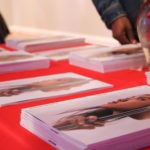
Gazing upon Queen Elizabeth II’s time-wizened, 90-year-old face, it is easy to forget her youth. At age 10, she was uprooted from a relatively quiet childhood spent between her family’s private apartments in London and countryside estate in Berkshire when her father, King George VI, was called upon to ascend the throne. Elizabeth’s own ascension would take place a mere 15 years later, a few months after her 27th birthday.
“The Crown,” a Netflix original series that premiered Friday, opens in 1947, the year of Elizabeth’s wedding. Played by Claire Foy, she is a doe-eyed, blushing bride, trembling almost unperceivably as she recites her wedding vows. But, as Elizabeth stands upon the precipice of her new life with Prince Phillip, her father (Jared Harris) is inches closer to death.
The juxtaposition of the two — father and daughter, life and death — is as poignant as it is tense. While “The Crown” does heavily foreshadow King George VI’s death, it neither rushes him to the grave nor accelerates his family’s mourning.
Rather, the program intimately portrays the king’s battle with lung cancer, opening on a shot of George, alone, retching up blood in a Buckingham bathroom. Once a great monarch who guided his country through a war unprecedented in its atrocity, he has been reduced to a man who fusses about the proper application of makeup intended to mask his illness.
The severity of his condition grows alongside a steadily multiplying pile of bloodied rags, delicately tucked away in a wooden box. Later, his surgically removed lung is carefully wrapped in newspaper by a palace nurse.
George’s decline is not that of a once-great man. It is that of a loved one. Particularly, a father. And while a bloodier portrayal of his dying days would have been cinematically striking, the mementos of his illness are deeply personal, even familiar.
The fragility they reveal is heartbreaking, only compounded by the intermittently tearful gazes of those closest to him who are witnessing their beloved king, father and friend struggle to speak.
George’s death sets the tone for “The Crown” and its portrayal of royal life. One of his last actions is even aimed at the furthering of that tone, when he presents a newly married Elizabeth with what has been identified as a “cine-camera,” essentially a 1940s camcorder used principally by amateur filmmakers. In handing Elizabeth that camera, George gives not only his daughter but also viewers of “The Crown” a unique gift: a record of Elizabeth’s reign from her perspective.
The queen, after all, is a famously private woman. And while a journey through her cinematic memories still isn’t quite as intimate an acquaintance as viewers of “The Crown” might desire, what Elizabeth chooses to record is incredibly revealing.
Like most 20-somethings today, she documents her highlights. Those highlights, however, are self-determined and have little to do with prestige or opulence. While the press photographs her family’s goings-on at Buckingham, Elizabeth films her baby belly and beach getaways. She loves her family and treasures life’s simpler pleasures, like the sea-breeze on a sunny day or sighting an exotic animal.
Unfortunately, also like most 20-somethings, Elizabeth is struck by a rather acute quarter-life crisis, a call to ascend the throne upon her father’s death. Her light-hearted recordings and plans for the future come to an abrupt end; the influence of her perspective on the telling of her narrative, however, does not.
“The Crown” is like a blend of “Downton Abbey” and “House of Cards,” visually similar to the former but politically motivated like the latter. Despite his brief life span in “The Crown,” Harris’ performance as King George VI is so affecting that there is a hole in the program’s dynamic after his death that works to its benefit, giving his fellow actors proper emotional cause to grieve his loss.
Foy’s refreshingly youthful portrayal of Queen Elizabeth II will resonate, in particular, with 20-somethings only really familiar with the queen as a grandmotherly figure.
For the first time, TV viewers are given insight into the mind of England’s longest-reigning monarch and tremendous empathy regarding her acquisition of that power. “The Crown” is slated to run for a total of six seasons. With any luck, progressive seasons will only delve deeper into Elizabeth’s mysterious inner-life, further charting the personal narrative of her maturation into the queen we know today.




